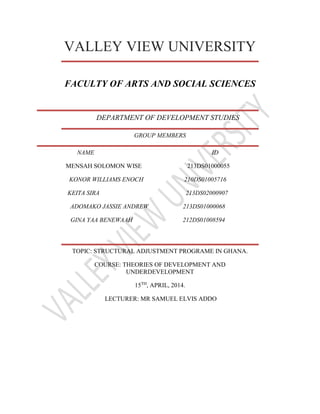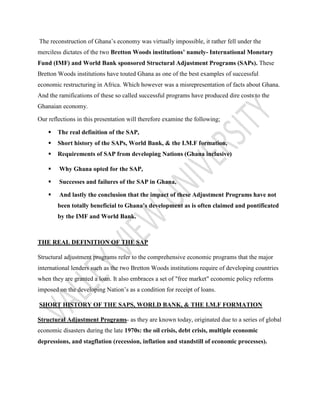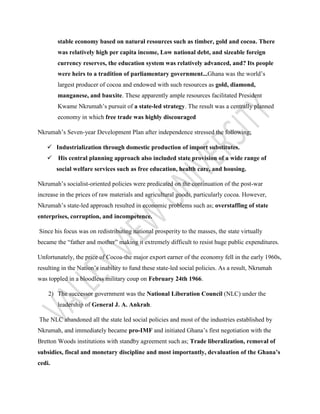This document provides background information on Ghana's Structural Adjustment Program (SAP) implemented in 1983. It discusses Ghana's deteriorating economic situation following independence that led successive governments to seek assistance from international lenders. Ghana was compelled to accept the SAP promoted by the IMF and World Bank to receive loans. The SAP required Ghana to implement free market reforms like privatization, trade liberalization, currency devaluation and cuts to social spending. The document examines the origins and requirements of the SAP as well as its impacts on Ghana's development.
















![UNICEF data, as many as 5,000,000 children and vulnerable adults may have lost their lives
in this blighted continent as a result of the debt crunch.
These programs cannot be said to be an intervention to a Nation’s already sickening economy
but rather a thorn in the flesh of the Nation’s progress. However, in a more cynical or harsher
description, structural adjustments and other trade related policies could also be seen as a
“weapon of mass destruction” as Raj Patel hints, (commenting on the Doha WTO conference
in November, 2001.)
NB- A fertilizer bombs that kills 100 in Oklahoma and Fuel-laden civil jets that kill 4000 in
New York cannot be compared to a sanction policy that kills 1 and a half million in Iraq
and a trade policy that bleeds continents to death.
You can make a bomb out of anything but the ones on paper hurt the most.
However, we have seen that the achievement of the social well-being of our people is
not an integral component of SAPs as claimed by the two Bretton Woods
institutions, but a hoped-for result of applying free market principles to the
economy. A process of adjustment, as described by many World Bank and IMF
officials to developing countries, is one of a "sacrifice," of one’s "present pain for
future hope." SAPs are based on a narrow economic model that perpetuates
poverty, inequality, and environmental degradation.
BIBLIOGRAPHY/REFERENCES
Susan George, A Fate Worse Than Debt, (New York: Grove Weidenfeld, 1990), pp. 143,
187, 235
The U.S. uses its dominant role in the global economy and in the IFIs [International
Financial Institutions] to impose SAPs on developing countries and open up their markets
to competition from U.S. companies.
Carol Welch, Structural Adjustment Programs & Poverty Reduction Strategy, Foreign
Policy in Focus, Vol 5, Number 14, April 2000
Raj Patel, They also make bombs out of paper, ZNet, November 28, 2001](https://image.slidesharecdn.com/8a2026b6-09dc-4238-8d19-56655a82142f-160505201335/85/Structural-Adjustment-Programmes-in-Ghana-17-320.jpg)
